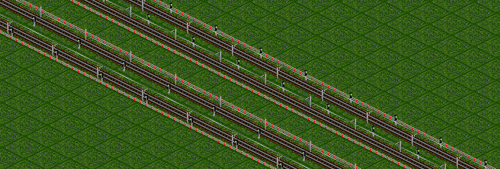Difference between revisions of "Mainline"
From #openttdcoop wiki
(Basics of a ML page) |
(Wasn't sure about the size, just made the picture large enough to see...) |
||
| Line 2: | Line 2: | ||
{{reqscreenshot}} | {{reqscreenshot}} | ||
Mainlines (ML) are the most important tracks in our cooperative games, they form the 'core' of the network, and allow timely movement of cargo. Mainlines can range in size from two tracks up to five or more, they usually run in both directions, but depending on the plan these may run in one. | Mainlines (ML) are the most important tracks in our cooperative games, they form the 'core' of the network, and allow timely movement of cargo. Mainlines can range in size from two tracks up to five or more, they usually run in both directions, but depending on the plan these may run in one. | ||
| − | [[Image:Mainline.png|thumb|none| | + | [[Image:Mainline.png|thumb|none|500px|A LL_RR bi-directional ML]][[Image:BigML.png|thumb|60px|none|A LLLL single direction ML]] |
<!-- feel free to change the filenames, and/or track sizes --> | <!-- feel free to change the filenames, and/or track sizes --> | ||
Flow on a mainline is paramount, nothing should interrupt clean flow of traffic. As per the [[Basic Networking#Line Hierarchy|Line Hierarchy]] MLs have the highest priority of any track, and anything joining (say a [[Sideline]]), must yield track space, to ML traffic. ([[SML]]'s work slightly differently, by ML trains making space if possible, but this principle still holds true on those). | Flow on a mainline is paramount, nothing should interrupt clean flow of traffic. As per the [[Basic Networking#Line Hierarchy|Line Hierarchy]] MLs have the highest priority of any track, and anything joining (say a [[Sideline]]), must yield track space, to ML traffic. ([[SML]]'s work slightly differently, by ML trains making space if possible, but this principle still holds true on those). | ||
Revision as of 02:13, 5 November 2009
| Please help improve this article or section by expanding it. Further information might be found on the talk page. |
| It is requested that a screenshot or screenshots be included in this article to improve or clarify it's content. |
Mainlines (ML) are the most important tracks in our cooperative games, they form the 'core' of the network, and allow timely movement of cargo. Mainlines can range in size from two tracks up to five or more, they usually run in both directions, but depending on the plan these may run in one.
Flow on a mainline is paramount, nothing should interrupt clean flow of traffic. As per the Line Hierarchy MLs have the highest priority of any track, and anything joining (say a Sideline), must yield track space, to ML traffic. (SML's work slightly differently, by ML trains making space if possible, but this principle still holds true on those).
Since, we try to pack as many trains as possible onto the MLs, Signalling distance is every other tile, any interruptions to signalling must be compensated for. For this reason, it common to see sections of ML split into two or more tracks briefly and later merge. This type of construct is called a Line sync, a basic example of which is show here;
The LL_RR terminology denotes the default layout for all MLs on a map.
- In LL__RR: LL shows that there are two left direction tracks, __ shows there is a two tile gap, RR shows two right direction tracks
- In L_L_L10R_R_R: L_L_L shows three left direction tracks, with a one tile separator, 10 shows a ten tile gap, R_R_R shows three right direction tracks, with a one tile separator.
